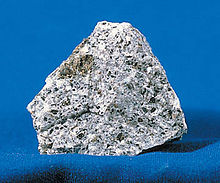Syenite
Igneous rock | |
 | |
| Composition | |
|---|---|
| Classification | Felsic |
| Plagioclase and K-Feldspars, depleted in quartz | |
| Texture | Aphanitic |
| Equivalents | Trachyte extrusively |

Syenite is a coarse-grained intrusive igneous rock with a general composition similar to that of granite, but deficient in quartz, which, if present at all, occurs in relatively small concentrations (< 5%). It is considered a granitoid. Some syenites contain larger proportions of mafic components and smaller amounts of felsic material than most granites; those are classed as being of intermediate composition.
The extrusive equivalent of syenite is trachyte.[1]
Composition
The
When
Other common accessory minerals are apatite, titanite, zircon and other opaques.
Most syenites are either
Formation
Partial melting
Syenites are products of alkaline igneous activity, generally formed in thick continental crustal areas, or in Cordilleran subduction zones. The formation of syenites can be theorized to be from the melt of granitic or igneous protolith to a fairly low degree of partial melting. This is required because potassium is an incompatible element and tends to enter a melt first, whereas higher degrees of partial melting will liberate more calcium and sodium, which produce plagioclase, and hence a granite, adamellite or tonalite.
At very low degrees of partial melting a
Conversely in certain conditions, large volumes of anorthite crystals may precipitate from thoroughly molten magma in a cumulate process as it cools. This leaves a drastically reduced concentration of silica in the remainder of the melt. The segregation of the silica from the melt leaves it in a state that may favour syenite formation.[citation needed]
Fractional crystallization
Some syenites are also theorized to be the product of the fractional crystallization of basaltic magmas.[2]
Occurrence

Syenite is not a common rock. Regions where it occurs in significant quantities include the following.
- In the Kola Peninsula of Russia two giant nepheline syenite bodies exists making up the Lovozero Massif and the Khibiny Mountains. These syenites are part of the Kola Alkaline Province.[3]
- In North America syenite occurs in fluorescent sodalite, were moved from Canada to Michigan by glaciers;[5] these glacial erratic pebbles have been given the trade name "yooperlite".[6] In other parts of the world, these types of rocks are known as sodalite-syenite and occur in Canada, India, other US states, Greenland, Malawi, and Russia.[citation needed]
- In Europe syenite may be found in parts of Switzerland, Germany, Norway, Portugal, Sweden, Scotland,[7] in Plovdiv, Bulgaria and in Ditrău, Romania.
- In Africa there are syenite formations in Aswan, Egypt, and in Malawi in the Mulanje Mountain Forest Reserve. Syenite rock was used to make the Quay with Sphinxes.
- In Australia syenite occurs as small intrusive bodies in nearly every state. In New South Wales, a large syenite intruded during the breakup of Gondwana in the Cretaceous.
- Paatusoq and Kangerluluk fjords in southeastern Greenland, where a bay within the latter (Syenitbugt) and a headland (Syenitnæs) are named after the rock.[8]
Etymology
The term syenite was originally applied to hornblende granite like that of
Episyenite
Episyenite (or epi-syenite) is a term used in
Episyenites are heterogenous in their properties, but all have experienced nearly complete disappearance of quartz at sub-
In addition to rare earth elements,[10] episyenites may be important sources of uranium[12] and other valuable metals.[11]
Notable occurrences of episyenite are found in the Central Iberian Massif of Spain,[9] in Cambrian to Ordovician beds of New Mexico and Colorado,[10] Scandinavia, Brazil, and Ukraine.[11]
See also
References
- E. Wm. Heinrich. Microscopic Petrography, McGraw-Hill, 1956
- )
- ^ "ALEX STREKEISEN-Syenite-".
- (PDF) from the original on 2017-01-10.
- ISBN 9785880484188. Retrieved 2 December 2014.
- ^ "'Yooperlite' a new rock found in the Upper Peninsula". wilx.com. September 7, 2018. Retrieved 8 September 2018.
- ^ "Yooperlite". Mindat.org. Retrieved 9 November 2019.
- ISBN 9781780460093.
- ^ "Syenitnaes". Mapcarta. Retrieved 6 May 2016.
- ^ .
- ^ a b c McLemore, Virginia T. (2016). "Episyenites in the Sevilleta National Wildlife Refuge, Socorro County, New Mexico: preliminary results" (PDF). New Mexico Geological Society Field Conference Series. 67: 255–262. Archived (PDF) from the original on 2020-06-11. Retrieved 11 June 2020.
- ^ S2CID 201313988.
- .
